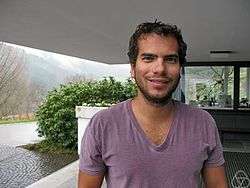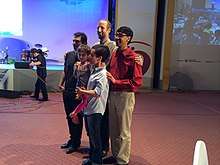Artur Avila
| Artur Avila | |
|---|---|
 Avila in Oberwolfach in 2012. | |
| Born |
29 June 1979 Rio de Janeiro, Brazil |
| Residence |
Rio de Janeiro, Brazil Paris, France |
| Citizenship | Brazilian and French[1] |
| Education |
Instituto Nacional de Matemática Pura e Aplicada (PhD and MS) Federal University of Rio de Janeiro (BS) |
| Known for |
Dynamical systems Spectral theory Zorich–Kontsevich conjecture Ten martini problem |
| Awards |
Fields Medal (2014) Michael Brin Prize in Dynamical Systems (2011) EMS Prize (2008) Salem Prize (2006) Gold medal at the International Mathematical Olympiad (1995) |
| Scientific career | |
| Fields | Mathematics |
| Institutions |
IMPA, CNRS Paris Diderot University (Paris 7) Instituto Nacional de Matemática Pura e Aplicada |
| Thesis | Bifurcações de tranformações unimodais sob os pontos de vistas topológico e métrico (2001) |
| Doctoral advisor | Welington de Melo |
Artur Avila Cordeiro de Melo (born 29 June 1979) is a Brazilian and French mathematician working primarily on dynamical systems and spectral theory. He is one of the winners of the 2014 Fields Medal,[2] being the first Latin American to win such award. He is a researcher at both the IMPA and the CNRS (working a half-year in each one).
Biography
At the age of 16, Avila won a gold medal at the 1995 International Mathematical Olympiad[3] and received a scholarship for the Instituto Nacional de Matemática Pura e Aplicada (IMPA) to M.S. while still attending high school in Colégio de São Bento and Colégio Santo Agostinho in Rio de Janeiro.[4] Later he enrolled in the Federal University of Rio de Janeiro (UFRJ), earning his B.S in mathematics.[5]
At the age of 19, Avila began making his doctoral thesis on the theory of dynamical systems. In 2001 he finished it and received his PhD from IMPA. That same year he moved abroad to France to do postdoctoral research.[6] He works with one-dimensional dynamics and holomorphic functions.[7] Since 2003 he has worked as a researcher for the Centre National de la Recherche Scientifique (CNRS) in France, later becoming a research director in 2008. His post-doctoral supervisor was Jean-Christophe Yoccoz.[8]
In 2005, at age 26, Arthur became known amongst mathematicians for proving the "Conjecture of the ten martinis", a problem proposed in 1980 by the American mathematical physicist Barry Simon. Simon promised to pay ten martini doses to whoever explained his theory about the behavior of "Schrödinger operators", mathematical tools related to quantum physics. Artur solved the problem along with mathematician Svetlana Jitomirskaya[9][10] and was rewarded with a few rounds of martini.
Prizes

Later, as a research mathematician, he received in 2006 a CNRS Bronze Medal as well as the Salem Prize, and was a Clay Research Fellow. He became the youngest professorial fellow (directeur de recherches) at the CNRS in 2008. The same year, he was awarded one of the ten prestigious European Mathematical Society prizes, and in 2009 he won the Grand Prix Jacques Herbrand from the French Academy of Sciences. In 2017 he gave the Łojasiewicz Lecture (on the "One-frequency Schrödinger operators and the almost reducibility conjecture") at the Jagiellonian University in Kraków.[11]
He was a plenary speaker at the International Congress of Mathematicians in 2010.[12] In 2011, he was awarded the Michael Brin Prize in Dynamical Systems. He received the Early Career Award from the International Association of Mathematical Physics in 2012,[13] TWAS Prize in 2013[14] and the Fields Medal in 2014.[15]
Mathematical work
In 2005, together with Svetlana Jitomirskaya, he solved the ten martini problem,[10] and together with Marcelo Viana, he proved the Zorich–Kontsevich conjecture.[16]
Notes and references
- ↑ http://www.math.jussieu.fr/~artur/cur.pdf
- ↑ The Guardian
- ↑ Web-site of the International Mathematical Olympiad: Brazil at the 36th IMO (1995)
- ↑ Talarico, Bruna (16 January 2010), "Gênio da matemática carioca", O Dia Online (in Portuguese), archived from the original on 22 January 2010
- ↑ Moreira Salles, João (January 2010), "Artur tem um problema", Piauí (in Portuguese), archived from the original on 30 June 2015
- ↑ Vanessa Fajardo (12 August 2014). "Pesquisador brasileiro ganha prêmio equivalente a 'Nobel' de matemática". G1.
- ↑ "Artur Avila". Clay Mathematics Institute.
- ↑ []
- ↑ "Solving the Ten Martini Problem" (PDF) (in Portuguese).
- 1 2 Avila, Artur; Jitomirskaya, Svetlana (2005). "Solving the Ten Martini Problem". The Ten Martini Problem. Lecture Notes in Physics. 690. pp. 5–16. arXiv:math/0503363. doi:10.1007/3-540-34273-7_2. ISBN 978-3-540-31026-6.
- ↑ "2017 Lecture - Institute of Mathematics of the Jagiellonian University". www.im.uj.edu.pl. Retrieved 2017-06-25.
- ↑ "ICM Plenary and Invited Speakers since 1897". International Congress of Mathematicians.
- ↑ The IAMP Early Career Award
- ↑ "Prizes and Awards". The World Academy of Sciences. 2016.
- ↑ 2014 IMU Prize Winners
- ↑ Avila, Artur; Jitomirskaya, Svetlana (2005). "Simplicity of Lyapunov spectra: Proof of the Zorich-Kontsevich conjecture". arXiv:math/0508508.
Further reading
- Lin, Thomas; Klarreich, Erica (12 August 2014). "A Brazilian Wunderkind Who Calms Chaos". Quanta Magazine.
- Moreira Salles, João. "Artur has a problem" (translated from the Portuguese by F. Thomson-Deveaux). Piauí Magazine.